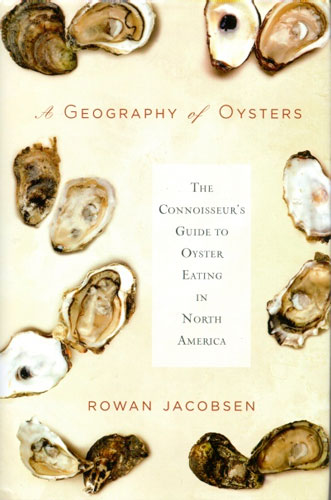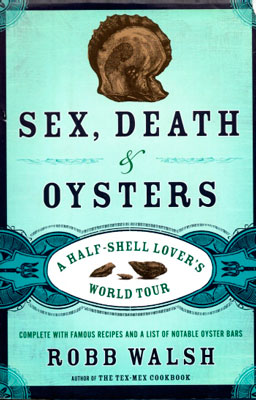A review of two books on oysters that follow different paths, featuring a digression on the lifestyle of the fortunate oyster.
In A Geography of Oysters, Rowan Jacobsen notes that “[m]any people have written books on the subject of oysters, but only two have nailed it.” (Jacobsen 283) His thoughtful and good-humored volume makes it three. A Geography ranges around the globe to chart the different forms of oyster production, harvesting, flavors and foodways, but the title reflects more than that.
He can turn a nice phrase and spin a good analogy. “Look,” for example, “at an Eastern oyster and you see a hard-bitten New Englander…. Clearly, this is an oyster conditioned by many brutal winters to adopt a viewpoint all too familiar to us Northeasterners: Build yourself a strong house and don’t show off too much.” (Jacobsen 18)
Jacobsen demonstrates that like the value of real estate, there are three major factors that influence the flavor of an oyster; location, location and location. Local characteristics like vegetation, the strength of water currents, its temperature, salinity and mineral content trump even species (although only five oyster species exist) in determining the shape, texture and size of an oyster.
The earliest humans ate oysters with enthusiasm as soon as they figured out what lay within the forbidding shell. Then, the oyster “was almost too good to be true--a year-round protein source that doesn’t run away.” (Jacobsen 30)

It was a revelation, at least to the Editor, that people have cultivated oysters nearly as long as they have eaten the unlikely treats:
“The Greeks, Chinese, Japanese, and Mesoamericans all independently hit upon the first step toward farming oysters. They noticed that the same places where oyster seed set well were not necessarily the same places where adult oysters thrived, or tasted best…. The first efforts at farming oysters involved growing seed oysters in gentler and fresher water, where they endured fewer predators. Then, as their shells toughened and their appetites increased, they could be ‘fattened’ in areas with active flow and full salinity.” (Jacobsen 31)
Romans in Britain discovered the same thing by accident. They found it arduous to venture offshore to the great oyster reefs on a regular basis (undisturbed oysters in the right conditions will breed upon the shells of their ancestors like coral, another lesson learned from Jacobsen) so brought oysters into tidal pools for storage. The oysters that lived long enough in pools at the mouths of rivers tasted better so the practice evolved to promote flavor as well as convenience.
The early English in turn innovated by digging special beds, or ‘layings’ to store and season their oysters. Aquaculture in the United States began with the oyster, at the Cotuit Oyster Company in 1837. The firm still exists.
‘Aquaculture’ itself conjures accurate images of awful pollution. Salmon for instance require quantities of feed and produce a great amount of excrement in a restricted area, and both substances contain dire amounts of nitrogen and phosphorus that are damaging to most forms of marine life. Oyster production, however, is beyond clean. Oysters require no feed, filter some fifty gallons of water a day to consume plankton and algae (too much algae deoxygenates water with disastrous results for the ecosystem) and actually remove nitrogen from the water.
It is not just the oysters but also their farmers that improve water quality and support the ecosystem. They only can do well by doing good.
“As a group, oyster farmers are rabid about water quality. Their livelihood depends on it. Bad water equals no oysters or oysters that can’t be sold. Oyster farmers end up devoting a lot of time, energy, and money to improving water quality in their area.” (Jacobsen 61)
Jacobsen wears his knowledge lightly. The chapter on “Being an Oyster” is amusing as well as informative because it is written from the oyster’s point of view. “Say you are an oyster…. For starters, you wouldn’t grow just anywhere. No open sea for you…. ” Instead oysters do best in protected river mouths where salinity is low, nutrients are rich and the fury of storms may be dissipated. (Jacobsen 27-28) The first two of those factors also improve the flavor of oysters.
Only one in ten thousand sprats manages to ‘set’ and grow shells, but “the planktonic gods are kind” so “you are a lucky oyster,” if only in a minimalist sense. “As a larva, you have a few things going for you, along with some serious problems. Your main problem is that you are very small, and pretty tasty, so more likely than not you are going to end your very brief life as lunch.” (Jacobsen 28)
Your attributes include cilia that enable you to swim, a sticky foot that might despite the odds allow you to set and a rudimentary eye sensing degrees of light to help you on your way. It all is too good to last if you do:
“Once settled in your new home, off go the eye, the foot, the cilia. You’ll never travel or see again…. It’s a bit like being a Hindu mystic. Your life path involves paring down to the bare essentials, making do with less. You find a nice spot, settle into the lotus posture, and do nothing but eat, breathe, and periodically blow off a third of your body mass in one titanic ejaculation…. Afterward, you have a wicked case of tristesse.” (Jacobsen 28-29)
On it goes, and we are happy to tag along. This biography of the oyster is followed logically enough by a chapter on “Being an Oyster Farmer,” which makes the case for supporting them. As an added bonus Jacobsen appreciates, in oyster terms, one of the Editor’s favorite parts of the world. “We can thank the jumbled geology of Massachusetts and Rhode Island for the amazing variety in the oysters found there…. Only Washington State can boast a wider range.” (Jacobsen 109)
Robb Walsh comes from Texas and adopts a silly macho persona in Sex, Death & Oysters, which does not have anything to do with death. The parts about sex are cringe inducing: Walsh ‘experiments’ on his wife to establish whether or not oysters are an aphrodisiac. He is the boastful bar bore who tells bad jokes and brags that he ate fifteen dozen oysters in under four hours to gain a place on the Acme Oyster House ‘Wall of Fame’ which, he belatedly notices, does not in fact exist except online where no one will find it. If a companion asks whether a species of fish tastes ‘fishy,’ Walsh tortures the waiter by asking whether the beef is ‘beefy’ or the pork ‘porky,’ and happily admits as much. (Walsh 64)
His religion is a faith in the primacy of the outsized. Bigger and more matter most. This judgment extends to flavor as well as size; intensity, whether pleasant or not, trumps subtlety or, for that matter, appeal. Walsh therefore obsesses over the Belon or European flat oyster, Ostrea edulis.

As Jacobsen warns, however, “[a]lmost everybody who tastes a Belon hates it. Even the people who sell them don’t like them…. Belons are off-putting and overwhelming, like an anchovy dipped in zinc; most peple can’t take them.” (Jacobsen 20-21) Granted some people like them, but it is hard in context not to ascribe some of their appeal as far as Walsh is concerned to the fishbomb extremity per se. He also hopes that the O. edulis is “a more potent aphrodisiac” than other oysters due to its high mineral content. (Walsh 62)
Woe to Walsh. The effect on his wife was akin to the proverbial cold shower. “It tastes,” she said of the edulis he goaded her to try, “like licking the bottom of a boat.” (Walsh 64) Less charitable descriptions come to the Editor’s mind.
Much of Sex, Death & Oysters recounts various episodes in which Walsh slurps oysters and drinks Martinis, beer or stout in oyster bars both humble and grand. If you like his company you will like the book, but beware; the writing is both clumsy and colloquial.
In fairness, he does provide some interesting background on the oyster in England and how its foodways have evolved. The oyster long was a staple of the poor before becoming a treat that, in Britain today, competes with caviar for luxury and prestige. We have cited him liberally in “On oysters: The British origin of a robust American tradition.” It appears this month in the lyrical.
Walsh’s perspective skews his judgment to produce some questionable conclusions. He properly decries the pollution that devastated oyster stocks on both sides of the English Channel during the nineteenth century, and concludes that regulation is superior to the free market where oysters are involved, a fair if not nuanced point. Walsh, however, oversimplifies the play between untrammeled markets and regulation.
“The English laissez-faire economic system, which relied on market forces and individual initiative, functioned beautifully during the Industrial Revolution. The French mercantile economic system, in which government intervened on behalf of key industries, was arguably less successful in the nineteenth century. But in the particular case of oysters, a resource which requires some management, government regulation proved good for business.”
In the mid-1800s, England and France each produced around 500 million oysters a year. Today England produces around 10 million oysters a year and France produces 2 billion oysters a year. History has proven that the French approach was the right one.” (Walsh 138)
This holds true but only in simplistic terms and up to a more complicated, wasteful point. First, virtually all the oysters produced by France are from the species O. gigas, imported from the west coast of the United States via Portugal, and not Walsh’s beloved Belons. Second, as Jacobsen realizes, raw numbers do not disclose the full gustatory story. He explains that
“in France, whose culinary connoisseurs sneered at gigas until they found that they had almost none of their beloved Belons left, then embraced the immigrant like a long-lost son. Today, so many Pacifics are grown in France that tens of thousands of tons get bulldozed annually to keep the price from collapsing.” (Jacobsen 18)
That is hardly a laudable let alone sustainable policy, and in fact the British oyster industry is hardly unregulated today. Walsh presents a lot of other big generalizations springing from equally little thoughtful analysis.
On balance then, Walsh does not make the cut and we will keep the number of good books written on the oyster at three. What are the other two? Find a copy of The Geography of Oysters, get the answer, enjoy yourself and learn a lot more as well.
Both books include a small number of serviceable recipes involving oysters, although some of the ones that Walsh advocates (oyster nachos?) appear more than a little dubious.

